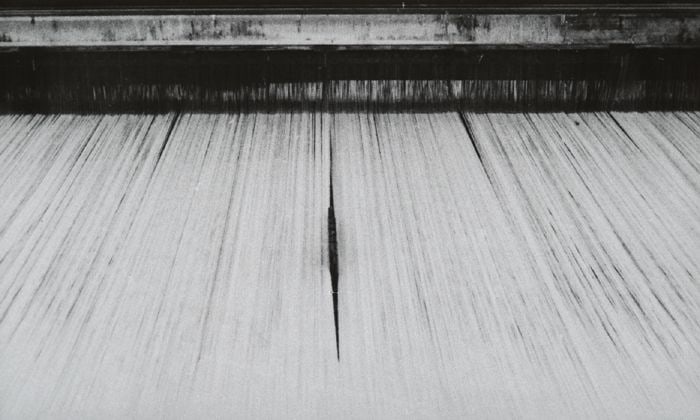
Untitled, ca. 1970s Black and white photograph
The photographs of Nasreen Mohamedi are a recent supplement to the drawings of this underknown Indian artist/ photographer/ writer. Fascinating in and of themselves, these 25 silver gelatin prints are being exhibited for the first time at Talwar Gallery.Some of Mohamedi’s photos were concurrently on view in “The Last Picture Show,” an exhibition of conceptual photography curated by Douglas Fogle for the Walker Art Center. Fogle became aware of Mohamedi’s photographs through Talwar Gallery’s director, who represents the artist’s estate.
Mohamedi was born in 1937 in a province of India which is now part of Pakistan. Trained in India, England, and France, where she came under the influence of the writer Helene Cixous, she was also a devotee of Zen. Mohamedi made drawings and took photographs as she traveled through Eastern and European cultures during the 1960s – 1980s. From the age of 22 until the end of her life, her poem-like diary entries reflect on the world while she moves within it as observer, artist, and participant. An example from 1988 reads:
Curve
Curve slowly coming to O.
Silence oasis in acoustic parks.
The vast scale of her images, materialized in silver gelatin prints no bigger than 11″ x 14″, belies the intimately subjective view through the camera that she maintains over her lifetime. Paradox is at the heart of her images. They describe a sublime and indeterminate realm on the periphery of iconic representation. A zeppelin shaped ellipse of light lifts off from the horizon below; tiny lights on the slim ground plane are all that anchor it. The linear qualities of closeup taut threads on a loom curiously, cottony, resemble orthogonal lines of perspective converging on an infinite point. Traffic lines painted on the street in Japan, together with characters for stop or slow, are depicted from the angle at which their distortion is most elongated. Terrace planting seen from a great distance and sand patterns also read as ambiguous in scale. The mobile, camera-assisted observer constructs outposts and touchstones by directing the photographic gaze toward an interiorized vision wherever she goes. As we befriend her vision, the world is both larger and smaller than we normally experience it.
The last prints in the exhibition correspond to the final years of Mohamedi’s life. They are extremely reductive and simply composed. Mohamedi photographed arched doorways from deep inside an architectural space. In these prints, the jet black, soft-edged shape of an arched doorway rests alone on a white expanse of paper. The extreme ends of the photographic process were the focus of her final experiments.
Does Mohamedi’s photographic work belong to conceptual photography, is it a lost body of work recovered? Fogle’s curatorial expertise says it is. So does Indian curator and writer Geeta Kapur, who places Mohamedi in the avant garde of Indian art in her recent book When was Modernism: Essays on Contemporary Cultural Practice in India. (New Delhi, 2000). Opposing Kapur’s postmodern approach, Tapati Guha-Thakurta argues for a more traditionally modernist contemporary art history of Indian art rich in a different political and aesthetic critique. More will be written about Nasreen Mohamedi in the near future. Meanwhile, her work and writing are an emerging treasure in the west.
-Deborah Garwood